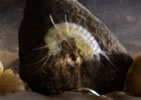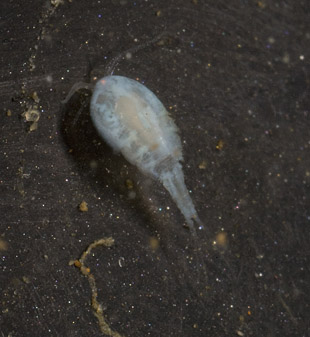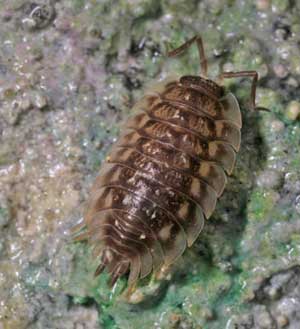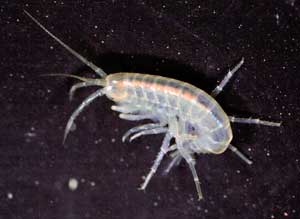Crustacea are arthropods, it means ‘joint feet’. There are many representatives of this phylum found underground, often in water; some of them are particularly ancient and found only in caves.
Ostracods mostly live in freshwater. They have a two part carapace (like a shell) but because they are small and difficult to identify there are few recordings.
Copepods have been identified in caves of the Peak District, with Cyclops sp. being found in numerous caves. Because they are very small (about 1mm or less) and difficult to identify, their importance in the underground ecosystem is probably underestimated. Copepods are possibly the most widespread type of crustacean found in subterranean waters and an examination of most cave pools will often find tiny ‘specks’ moving abou in the water and silt at the bottom.
|
Copepod in a footprint puddle, Peak Cavern |
Syncarida Anthobathynella stammeri is an eyeless, unpigmented species stygobitic species, the only stygobite recorded from caves in the north of England. It has a long thin body shape and is 1-1.5mm long. It is well adapted to living in the small spaces (the interstitial) in the gravels of streams and rivers from which it has mostly been recorded, although it is also known from caves and boreholes. It is widely distributed from Devon to the Midland valley of Scotland but there are few records, probably due to it being overlooked due to its small size and cryptic habitat.
Isopoda (means 'same footed') are crustaceans with a flattened body and 7 pairs of legs on 7 body segments, plus another 5 legless segments, the woodlouse is a typical example.
The Common Shiny Woodlouse, Oniscus asellus, has been identified from a number of Peak District caves. It is the most widely recorded woodlouse in caves.
|
Oniscus asellus, Thirst House Cave
The green colour is cyanobacter (bluegreen algae). |
The Rosy woodlouse Androniscus dentiger is able to maintain thriving populations deep underground. It is variable in colour (usually salmon pink) and is frequently found under stones and in rotting piles of wood (and outside in your compost heap). Although common further south it appears to be restricted by altitude in the north of England.
Other woodlice recorded from thresholds are Porcellio scaber, Trichoniscus pusillus, Trichoniscus pygmaeus and the more cavernicolous Rosy Woodlouse Androniscus dentiger.
The troglobite Isopod Proasellus cavaticus is not found in the northern England, its northern limit is mid Wales.
Amphipoda means "different-footed", and refers to the different forms of appendages these crustaceans have. Their bodies are flattened laterally (sideways) and the order includes the shrimps.
The northern Pennine caves do not have any records of the Niphargus family which includes the troglobitic cave shrimps. To the east of the Pennines Niphargus aquilex has been recorded from County Durham, Humberside and in the Magnesian limestones on the Lincolnshire/Yorkshire border.
It is thought the Niphargus species did not survive the glaciations in the north of England, but N. aquilex, which is commonly found in the gravel of streams and rivers, has probably been able to re-colonise northern England following the last ice age by being able to use the fluvial aquifers to disperse. The other Niphargus species are more restricted in their ability to colonise new regions due to the lack of connecting watercourses in their subterranean habitat.
All of the above species of cave shrimps are omnivores, eating whatever source of food they can find, including dead animals, decaying plant matter and even ingesting silt to extract the micro-flora (fungi & bacteria) associated with it.
The freshwater shrimp commonly seen in streams in northern England and elsewhere in Great Britain is Gammarus pulex. It does get washed into caves and appear to be able to thrive in the cave environment. Like some other creatures left in the dark they eventually become depigmented and white. If you look closely though you will see that they have eyes which appear to reflect your light. This is not apparent in the blind, white Niphargus species found further south.
Gammarus pulex is the crustacean you are most likely to see in streams in the caves of the Peak District. They are rare in the pools fed by seepage water alone. They are scavengers, browsing on microscopic plants, animals, and decomposing material. On the surface Gammarus are much more active at night than during the daylight hours.
|
Depigmented Gammerus pulex, Bagshawe Cavern |
Another species of surface-dwelling shrimp Crangonyx pseudogracilis has been recorded in most of England, Wales and is spreading through Scotland.
|




